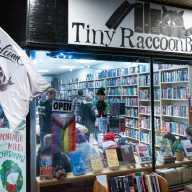
Ocean Beach residents and other concerned Fire Islanders made their way to the Ocean Beach Community House on the afternoon of Sunday, June 23, for the Village of Ocean Beach Environmental Commission’s 13th Annual Environmental Day. Guest speakers and free beer and food promised attendees a pleasant experience learning about the local environment, the health of the Great South Bay, and more.
Co-chairs Camille Guigliano and David Lieber kicked off the event with a few thank yous to those who pitched up tables for the event, including Blue Point Brewing Company, who provided the free beverages. The two continued on with some updates on the welfare of the Great South Bay.
“There are a lot of issues involved [with overfishing] globally, and it’s very discouraging. Our program today is done on a local level, and it’s meant to show you ways in which communities can work together to solve that problem,” Guigliano said.
“The health of the bay is at a critical point right now and it’s due to overharvesting, an abundance of nitrogen, and gross mismanagement of the bay,” Lieber added. “Politicians will fight in their arena. We the people need to come together to find solutions for the sake of our bays, our oceans, our drinking water and the planet.”
Guigliano and Lieber were followed by guest speaker Paul McCormick, owner of Great Gun Shellfish, who expanded on the issues mentioned and went in depth about the sustainability of his own
oyster farm and his work growing kelp with a Stony
Brook University lab.
“I established my farm in 2013, and it has been a phenomenal experience. I have a shallow water farm, oysters are growing on the surface, and the water depth ranges from a foot to 3-1/2 to 4 feet,” McCormick said. “I was very glad to be able to collaborate with Stony Brook when they approached me about my farm, wanting to grow sugar kelp. I felt challenged to succeed, and I had a great team behind me.”
The hope among both McCormick and the Stony Brook lab he worked alongside was that growing sugar kelp would improve the water quality of the farm and the bay. So far, they have been pleased with their results.
“Within two months we had [kelp] that was 4 feet long, and they were beautiful. It was amazing to watch this plant grow from mere millimeters to even 6 feet in length by mid-April,” he said. “We felt we broke the paradigm in not being able to grow this sugar kelp in shallow water. That was very exciting, it was a fantastic experience and I’m looking forward to growing more sugar kelp this winter.”
The next guest speaker, Stony Brook University Ph.D. candidate Stephen Tomasetti, worked alongside McCormick in Christopher Gobler’s lab. Tomasetti, who came on Gobler’s behalf, expressed similar excitement for the ongoing project.
“The grant we received from the USDA and the New York Farm Viability Institute was a very cool opportunity to collaborate with people in the region, and it’s all been about integrating kelp into existing oyster farms. What we do in the Gobler lab is look at the severity and persistence of stressful conditions associated with climate change and how those affect our oceans,” Tomasetti said.
“Even on the local scale we see these global processes at work affecting the bays, but they’re also being exacerbated by some of the human processes that we’re responsible for such as nitrogen loading, nutrient pollution and extra nitrogen coming into our waters through septic systems,” Tomasetti added.
However, Tomasetti and the Gobler lab have faith in the sugar kelp they have integrated into the Great South Bay as part of their project. Its benefits, Tomasetti said, tackle a significant amount of the environmental issues the bay is facing.
“One of the things we’re excited about in working with kelp is that it has the ability to fight back against some of the issues we see affecting our local waters,” he said. “For one thing, the kelp is actually 3 percent nitrogen, so that means it soaks up extra nitrogen, which allows it to grow. It can also pull in carbon dioxide that’s in the water, and produces oxygen. So we’re seeing kelp attacking each one of these issues in our water.”
The presentation concluded with a moderated question and answer session with the two guest speakers, as well as a complimentary lunch provided by Matthew’s, Hideaway, Island Mermaid, Castaway and Maguire’s – but not just any complimentary lunch – entrees made with sugar kelp! Flavorful, and nutritious, many are predicting it could become a new Long Island cash crop. Only time will tell.




























